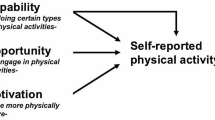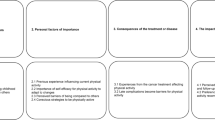Abstract
Purpose
Childhood cancer patients report low physical activity levels despite the risk for long-term complications that may benefit from exercise. Research is lacking regarding exercise barriers, preferences, and beliefs among patients (1) on- and off-therapy and (2) across the age spectrum.
Methods
Cross-sectional study in the Yale Pediatric Hematology-Oncology Clinic (October 2013–October 2014). Participants were ≥ 4 years old, > 1 month after cancer diagnosis at < 20 years, not acutely ill, expected to live > 6 months, and received chemotherapy and/or radiation. Participants (or parents if < 13 years) completed a survey.
Results
The 162 patients (99% participated) were 34% children (4.0–12.9 years), 31% adolescents (13.0–17.9 years), and 35% adults (≥ 18 years). Most had leukemia/lymphoma (66%); 32% were on-therapy. On-therapy patients were more likely than off-therapy patients (73 vs. 48%; p = 0.003) to report ≥ 1 barrier related to physical complaints, such as “just too tired” (46 vs. 28%; p = 0.021) or “afraid” of injury (22 vs. 9%; p = 0.027). The majority preferred walking (73%), exercising at home (91%), exercising in the afternoon (79%), and a maximum travel time of 10–20 min (54%); preferences did not vary significantly by therapy status or age. Most respondents (94%) recognized the benefits of exercise after cancer, but 50% of on- vs. 12% of off-therapy patients believed “their cancer diagnosis made it unsafe to exercise regularly” (p < 0.001).
Conclusions
Physical activity barriers pertaining to physical complaints and safety concerns were more pronounced in on-therapy childhood cancer patients but persisted off-therapy. Preferences and beliefs were relatively consistent. Our data can inform interventions in different patient subgroups.

Similar content being viewed by others
References
Howlader N NA, Krapcho M, Miller D, Bishop K, Altekruse SF, Kosary CL, Yu M, Ruhl J, Tatalovich Z, Mariotto A, Lewis DR, Chen HS, Feuer EJ, Cronin KA (eds). SEER Cancer Statistics Review, 1975-2013, National Cancer Institute. Bethesda, MD, http://seer.cancer.gov/csr/1975_2013/, based on November 2015 SEER data submission, posted to the SEER web site, April 2016
Myers RM, Balsamo L, Lu X, Devidas M, Hunger SP, Carroll WL, Winick NJ, Maloney KW, Kadan-Lottick NS (2014) A prospective study of anxiety, depression, and behavioral changes in the first year after a diagnosis of childhood acute lymphoblastic leukemia: a report from the children’s oncology group. Cancer 120(9):1417–1425. https://doi.org/10.1002/cncr.28578
Dupuis LL, Lu X, Mitchell HR, Sung L, Devidas M, Mattano LA, Jr., Carroll WL, Winick N, Hunger SP, Maloney KW, Kadan-Lottick NS (2016) Anxiety, pain, and nausea during the treatment of standard-risk childhood acute lymphoblastic leukemia: a prospective, longitudinal study from the children’s oncology group. Cancer 122 (7):1116–1125. doi:https://doi.org/10.1002/cncr.29876
Oeffinger KC, Mertens AC, Sklar CA, Kawashima T, Hudson MM, Meadows AT, Friedman DL, Marina N, Hobbie W, Kadan-Lottick NS, Schwartz CL, Leisenring W, Robison LL (2006) Chronic health conditions in adult survivors of childhood cancer. New England Journal of Medicine 355(15):1572–1582. https://doi.org/10.1056/NEJMsa060185
Veringa SJE, van Dulmen-den Broeder E, Kaspers GJL, Veening MA (2012) Blood pressure and body composition in long-term survivors of childhood acute lymphoblastic leukemia. Pediatr Blood Cancer 58(2):278–282. https://doi.org/10.1002/pbc.23251
Alvarez JA, Scully RE, Miller TL, Armstrong FD, Constine LS, Friedman DL, Lipshultz SE (2007) Long-term effects of treatments for childhood cancers. Curr Opin Pediatr 19(1):23–31. https://doi.org/10.1097/MOP.0b013e328013c89e
Mulrooney DA, Ness KK, Neglia JP, Whitton JA, Green DM, Zeltzer LK, Robison LL, Mertens AC (2008) Fatigue and sleep disturbance in adult survivors of childhood cancer: a report from the childhood cancer survivor study (CCSS). Sleep 31(2):271–281. https://doi.org/10.1093/sleep/31.2.271
Meacham LR, Sklar CA, Li S, Liu Q, Gimpel N, Yasui Y, Whitton JA, Stovall M, Robison LL, Oeffinger KC (2009) Diabetes mellitus in long-term survivors of childhood cancer. Increased risk associated with radiation therapy: a report for the childhood cancer survivor study. Arch Intern Med 169(15):1381–1388. https://doi.org/10.1001/archinternmed.2009.209
Dickerman JD (2007) The late effects of childhood cancer therapy. Pediatrics 119(3):554–568. https://doi.org/10.1542/peds.2006-2826
van der Sluis IM, van den Heuvel-Eibrink MM (2008) Osteoporosis in children with cancer. Pediatr Blood Cancer 50(2 Suppl):474–478; discussion 486. https://doi.org/10.1002/pbc.21407
Ness KK, Gurney JG (2007) Adverse late effects of childhood cancer and its treatment on health and performance. Annu Rev Public Health 28(1):279–302. https://doi.org/10.1146/annurev.publhealth.28.021406.144049
Shankar SM, Marina N, Hudson MM, Hodgson DC, Adams MJ, Landier W, Bhatia S, Meeske K, Chen MH, Kinahan KE, Steinberger J, Rosenthal D (2008) Monitoring for cardiovascular disease in survivors of childhood cancer: report from the cardiovascular disease task force of the children’s oncology group. Pediatrics 121(2):e387–e396. https://doi.org/10.1542/peds.2007-0575
Vina CC, Wurz AJ, Culos-Reed SN (2013) Promoting physical activity in pediatric oncology. Where do we go from here? Front Oncol 3:173. https://doi.org/10.3389/fonc.2013.00173
Mulhern RK, Tyc VL, Phipps S, Crom D, Barclay D, Greenwald C, Hudson M, Thompson EI (1995) Health-related behaviors of survivors of childhood cancer. Med Pediatr Oncol 25(3):159–165. https://doi.org/10.1002/mpo.2950250302
Keats MR, Courneya KS, Danielsen S, Whitsett SF (1999) Leisure-time physical activity and psychosocial well-being in adolescents after cancer diagnosis. Journal of pediatric oncology nursing: official journal of the Association of Pediatric Oncology Nurses 16(4):180–188. https://doi.org/10.1177/104345429901600402
Florin TA, Fryer GE, Miyoshi T, Weitzman M, Mertens AC, Hudson MM, Sklar CA, Emmons K, Hinkle A, Whitton J, Stovall M, Robison LL, Oeffinger KC (2007) Physical inactivity in adult survivors of childhood acute lymphoblastic leukemia: a report from the childhood cancer survivor study. Cancer epidemiology, biomarkers & prevention: a publication of the American Association for Cancer Research, cosponsored by the American Society of Preventive Oncology 16(7):1356–1363. https://doi.org/10.1158/1055-9965.epi-07-0048
Winter C, Muller C, Brandes M, Brinkmann A, Hoffmann C, Hardes J, Gosheger G, Boos J, Rosenbaum D (2009) Level of activity in children undergoing cancer treatment. Pediatr Blood Cancer 53(3):438–443. https://doi.org/10.1002/pbc.22055
Keats MR, Culos-Reed SN, Courneya KS, McBride M (2006) An examination of physical activity behaviors in a sample of adolescent cancer survivors. Journal of pediatric oncology nursing: official journal of the Association of Pediatric Oncology Nurses 23(3):135–142. https://doi.org/10.1177/1043454206287304
Djuric Z, Ellsworth JS, Weldon AL, Ren J, Richardson CR, Resnicow K, Newman LA, Hayes DF, Sen A (2011) A diet and exercise intervention during chemotherapy for breast cancer. The open obesity journal 3(1):87–97. https://doi.org/10.2174/1876823701103010087
Grabenbauer A, Grabenbauer AJ, Lengenfelder R, Grabenbauer GG, Distel LV (2016) Feasibility of a 12-month-exercise intervention during and after radiation and chemotherapy in cancer patients: impact on quality of life, peak oxygen consumption, and body composition. Radiat Oncol 11(1):42. https://doi.org/10.1186/s13014-016-0619-5
Le A, Mitchell HR, Zheng DJ, Rotatori J, Fahey JT, Ness KK, Kadan-Lottick NS (2016) A home-based physical activity intervention using activity trackers in survivors of childhood cancer: a pilot study. Pediatr Blood Cancer 64(2):387–394. https://doi.org/10.1002/pbc.26235
Mendoza JA, Baker KS, Moreno MA, Whitlock K, Abbey-Lambertz M, Waite A, Colburn T, Chow EJ (2017) A Fitbit and Facebook mHealth intervention for promoting physical activity among adolescent and young adult childhood cancer survivors: a pilot study. Pediatr Blood Cancer 64(12). https://doi.org/10.1002/pbc.26660
Jankowski CM, Ory MG, Friedman DB, Dwyer A, Birken SA, Risendal B (2014) Searching for maintenance in exercise interventions for cancer survivors. Journal of cancer survivorship: research and practice 8(4):697–706. https://doi.org/10.1007/s11764-014-0386-y
Demark-Wahnefried W, Werner C, Clipp EC, Guill AB, Bonner M, Jones LW, Rosoff PM (2005) Survivors of childhood cancer and their guardians. Cancer 103(10):2171–2180. https://doi.org/10.1002/cncr.21009
Arroyave WD, Clipp EC, Miller PE, Jones LW, Ward DS, Bonner MJ, Rosoff PM, Snyder DC, Demark-Wahnefried W (2008) Childhood cancer survivors’ perceived barriers to improving exercise and dietary behaviors. Oncol Nurs Forum 35(1):121–130. https://doi.org/10.1188/08.onf.121-130
Demark-Wahnefried W, Aziz NM, Rowland JH, Pinto BM (2005) Riding the crest of the teachable moment: promoting long-term health after the diagnosis of cancer. J Clin Oncol 23(24):5814–5830. https://doi.org/10.1200/jco.2005.01.230
Kann L, Kinchen S, Shanklin SL, Flint KH, Kawkins J, Harris WA, Lowry R, Olsen EO, McManus T, Chyen D, Whittle L, Taylor E, Demissie Z, Brener N, Thornton J, Moore J, Zaza S (2014) Youth risk behavior surveillance—United States, 2013. MMWR supplements 63(4):1–168
Nelson DE, Holtzman D, Bolen J, Stanwyck CA, Mack KA (2001) Reliability and validity of measures from the behavioral risk factor surveillance system (BRFSS). Sozial- und Praventivmedizin 46(Suppl 1):S3–42
CDC Division of Nutrition and Physical Activity (1999) Promoting physical activity: a guide for community action. Human Kinetics, Champaign, Ill
Kroll T, Kehn M, Ho P-S, Groah S (2007) The SCI exercise self-efficacy scale (ESES): development and psychometric properties. The International Journal of Behavioral Nutrition and Physical Activity 4(1):34–34. https://doi.org/10.1186/1479-5868-4-34
Wright M (2015) Physical activity participation and preferences: developmental and oncology-related transitions in adolescents treated for cancer. Physiotherapy Canada Physiotherapie Canada 67(3):292–299. https://doi.org/10.3138/ptc.2014-25LHC
Physical Activity Guidelines Advisory Committee (2008) 2008 physical activity guidelines for Americans. U.S. Department of Health and Human Services, Washington, DC
Zabora J, BrintzenhofeSzoc K, Curbow B, Hooker C, Piantadosi S (2001) The prevalence of psychological distress by cancer site. Psychooncology 10(1):19–28.
Institute of M, National Research C (2006) From cancer patient to cancer survivor: lost in transition. The National Academies Press, Washington, DC. https://doi.org/10.17226/11468
Collins JJ, Byrnes ME, Dunkel IJ, Lapin J, Nadel T, Thaler HT, Polyak T, Rapkin B, Portenoy RK (2000) The measurement of symptoms in children with cancer. J Pain Symptom Manag 19(5):363–377. https://doi.org/10.1016/S0885-3924(00)00127-5
Miller E, Jacob E, Hockenberry MJ (2011) Nausea, pain, fatigue, and multiple symptoms in hospitalized children with cancer. Oncol Nurs Forum 38(5):E382–E393. https://doi.org/10.1188/11.onf.e382-e393
Puetz TW (2006) Physical activity and feelings of energy and fatigue: epidemiological evidence. Sports Med 36(9):767–780. https://doi.org/10.2165/00007256-200636090-00004
Mustian KM, Sprod LK, Janelsins M, Peppone LJ, Mohile S (2012) Exercise recommendations for cancer-related fatigue, cognitive impairment, sleep problems, depression, pain, anxiety, and physical dysfunction: a review. Oncology & hematology review 8(2):81–88. https://doi.org/10.17925/OHR.2012.08.2.81
Schmitz KH, Courneya KS, Matthews C, Demark-Wahnefried W, Galvao DA, Pinto BM, Irwin ML, Wolin KY, Segal RJ, Lucia A, Schneider CM, von Gruenigen VE, Schwartz AL (2010) American College of Sports Medicine roundtable on exercise guidelines for cancer survivors. Med Sci Sports Exerc 42(7):1409–1426. https://doi.org/10.1249/MSS.0b013e3181e0c112
Gotte M, Kesting S, Winter C, Rosenbaum D, Boos J (2014) Experience of barriers and motivations for physical activities and exercise during treatment of pediatric patients with cancer. Pediatr Blood Cancer 61(9):1632–1637. https://doi.org/10.1002/pbc.25071
Keats MR, Culos-Reed SN, Courneya KS (2007) An examination of the beliefs, attitudes and counselling practices of paediatric oncologists toward physical activity: a provincial survey. Paediatr Child Health 12(4):289–293. https://doi.org/10.1093/pch/12.4.289
Kelly AK (2011) Physical activity prescription for childhood cancer survivors. Curr Sports Med Rep 10(6):352–359. https://doi.org/10.1249/JSR.0b013e318237be40
Miliaresis C, Beker S, Gewitz M (2014) Cardiopulmonary stress testing in children and adults with congenital heart disease. Cardiol Rev 22(6):275–278. https://doi.org/10.1097/crd.0000000000000039
Connelly J, Kirk A, Masthoff J, MacRury S (2013) The use of technology to promote physical activity in type 2 diabetes management: a systematic review. Diabet Med 30(12):1420–1432. https://doi.org/10.1111/dme.12289
van den Berg MH, Schoones JW, Vliet Vlieland TP (2007) Internet-based physical activity interventions: a systematic review of the literature. J Med Internet Res 9(3):e26. https://doi.org/10.2196/jmir.9.3.e26
Funding
This work was supported by a grant from the Hyundai Hope on Wheels Foundation.
Author information
Authors and Affiliations
Corresponding author
Ethics declarations
Conflict of interest
The authors have full control of all primary data and agree to allow the journal to review the data if requested.
The authors declare that they have no conflict of interest.
Rights and permissions
About this article
Cite this article
Ross, W.L., Le, A., Zheng, D.J. et al. Physical activity barriers, preferences, and beliefs in childhood cancer patients. Support Care Cancer 26, 2177–2184 (2018). https://doi.org/10.1007/s00520-017-4041-9
Received:
Accepted:
Published:
Issue Date:
DOI: https://doi.org/10.1007/s00520-017-4041-9




